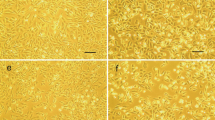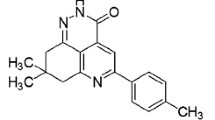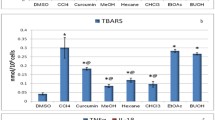Abstract
Purpose. Synthesize and evaluate the protective activity against tert-butylhydroperoxide-induced toxicity in freshly isolated rat hepatocytes of trans-kielcorin, trans-isokielcorin B, as well as their respective building blocks 3,4-dihydroxy-2-methoxyxanthone and 2,3-dihydroxy-4-methoxyxanthone.
Methods. Wistar rats, weighing 200-250g were used. Hepatocyte isolation was performed by collagenase perfusion. Incubations were performed at 37°C, using 1 million cells per milliliter in modified Krebs—Henseleit buffer. The protective activity was evaluated by measuring reduced and oxidized glutathione, lipid peroxidation and cell viability after inducing toxicity with tert-butylhydroperoxide (1.0 mM, 30 min), with or without the studied compounds in the concentrations of 0.025, 0.050, 0.100 and 0.200 mM. Silybin was tested in the same experimental conditions to serve as a positive control.
Results. Using these concentrations, the tested compounds prevented tert-butylhydroperoxide-induced lipid peroxidation and cell death in freshly isolated rat hepatocytes. All compounds were also effective in preventing perturbation of cell glutathione homeostasis in some extent. 3,4-Dihydroxy-2-methoxyxanthone and 2,3-dihydroxy-4-methoxyxanthone were more effective than trans-kielcorin and trans-isokielcorin B respectively. Silybin was less effective in protecting cells against lipid peroxidation and loss of cell viability than the four xanthonic derivatives.
Conclusions. The tested compounds protected the freshly isolated rat hepatocytes against tert-butylhydroperoxide-induced toxicity.
Similar content being viewed by others
REFERENCES
S. S. Handa, A. Sharma and Chakraborti. Natural products and plants as liver protecting drugs. Fitoterapia 17:307–351 (1986).
G. Vogel. Natural substances with effects on the liver. In H. Wagner and P. Wolff (eds.), New natural products and plant drugs with pharmacological, biological or therapeutical activity, Springer-Verlag, New York, 1977, pp. 249–263.
T. Cecchini, Enciclopedia de las hierbas y de las plantas medicinales Editorial De Vecchi, S.A., Barcelona, 1980.
R. Oliveira-Feijão, Medicina pelas plantas. 9a Edição. Livraria Progresso Editora, Lisboa, 1986.
M. M. M. Pinto, A. A. L. Mesquita and O. R. Gootlieb, Xanthonolignoids from Kielmeyra coriacea. Phytochemistry 26: 2045–2048 (1987).
E. G. R. Fernandes, M. M. M. Pinto, A. M. S. Silva, and J. A. S. Cavaleiro. Total synthesis, structural determination and biological activity of kielcorins B. In: Book of abstracts of the XIII International Symposium on Medicinal Chemistry, Paris, France, 19–23 September 1994, pp. 116P.
S. A. Jewell, D. DiMonte, P. Richelmi, G. Bellomo and S. Orrenius. Tert-butylhydroperoxide-induced toxicity in isolated hepatocytes: contribution of thiol oxidation and lipid peroxidation. J Biochem Toxicol 1:13–22 (1986).
M. Joyeux, A. Rolland, J. Fleurentin, J. Mortier and P. Dorfman. Tert-butylhydroperoxide-induced injury in isolated rat hepatocytes: a model for studying anti-hepatotoxic drugs. Planta Med. 56:171–174 (1990).
P. Moldéus, J. Högberg and S. Orrenius. Isolation and use of liver cells. Methods Enzymol 52:60–71 (1978).
F. D. Carvalho, F. Remião, P. Vale, J. A. Timbrell, M. L. Bastos and M. A. Ferreira, Glutathione and cysteine measurement in biological samples by HPLC with a glassy carbon working detector. Biom Chrom 8:134–136 (1994).
L. Eklow, P. Moldéus and S. Orrenius. Oxidation of glutathione during hydroperoxide metabolism. A study using isolated hepatocytes and the glutathione reductase inhibitor 1,3-bis(2-chloroethyl)-1-nitrosourea. Eur J Biochem 138:459–463 (1984).
G. Bellomo, F. Mirabeli, P. Richelmi and S. Orrenius. Critical role of sulfhydril group(s) in ATP-dependent Ca2+ sequestration by the plasma membrane fraction from rat liver. FEBS Lett 163:136–139 (1983).
H. G. Shertzer, G. L. Bannenberg, H. Zhu, R. M. Liu and P. Moldéus. The role of thiols in mitochondrial susceptibility to iron and tert-butyl hydroperoxide-mediated toxicity in cultured mouse hepatocytes. Chem Res Toxicol 7:358–366 (1994).
E. Cadenas and H. Sies. Low level chemiluminescence of liver microsomal fractions initiated by tert-butyl-hydroperoxide. Relation to microsomal hemoproteins, oxigen dependence, and lipid peroxidation. Eur. J. Biochem. 124:349–356 (1982).
X. Shan, T. Y. Aw, and D. P. Jones. Glutathione-dependent protection against oxidative injury. Pharmac Ther 47:61–71 (1990).
R. Campos, A. Garrido, R. Guerra and A. Valenzuela. Silybin dihemisuccinate protects against glutathione depletion and lipid peroxidation induced by acetaminophen on rat liver. Planta Med 55:417–419 (1989).
M. P. Miguez, I. Anundi, L. A. Sainz-Pardo and K. O. Lindros, Hepatoprotective mechanism of silymarin: no evidence for involvement of cytochrome P450 2E1. Chem Biol Interact 91:51–63 (1994).
H. Minami, M. Kinoshita, Y. Fukuyama, M. Kodama, T. Yoshizawa, M. Sugiura, K. Nakagawa and H. Tago, Antioxidant xanthones from garcinia subelliptica. Phytochemistry 36:501–506 (1994).
Author information
Authors and Affiliations
Rights and permissions
About this article
Cite this article
Fernandas, E.R., Carvalho, F.D., Remião, F.G. et al. Hepatoprotective Activity of Xanthones and Xanthonolignoids Against tert-Butylhydroperoxide-Induced Toxicity in Isolated Rat Hepatocytes—Comparison with Silybin. Pharm Res 12, 1756–1760 (1995). https://doi.org/10.1023/A:1016230125496
Issue Date:
DOI: https://doi.org/10.1023/A:1016230125496




